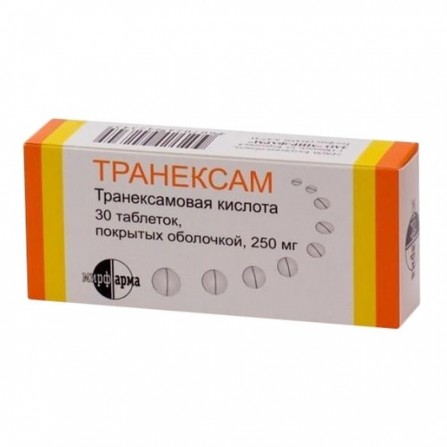Tranexam pills 250 mg 30 pcs
Condition: New product
999 Items
Rating:
Be the first to write a review!

More info
Active ingredients
Tranexamic acid
Release form
Pills
Composition
Active ingredient: Tranexamic acid Concentration of active ingredient (mg): 250 mg
Pharmacological effect
Hemostatic drug. Fibrinolysis inhibitor. It specifically inhibits plasminogen activation and its conversion to plasmin. It has a local and systemic hemostatic effect in bleeding associated with increased fibrinolysis (platelet pathology, menorrhagia). By suppressing the formation of kinins and other active peptides involved in allergic and inflammatory reactions, it has anti-allergic and anti-inflammatory effects.
Pharmacokinetics
Absorption When ingested in a dose of 0.5-2 g 30-50% of the drug is absorbed. When administered in doses of 0.5, 1 and 2 g, the time to reach Cmax is 5, 8 and 15 μg / ml, respectively, and is reached after 3 hours. Distribution Binding to plasma proteins (profibrinolysin) is less than 3%. Distributed in tissues relatively evenly (except for cerebrospinal fluid, where the concentration is 1/10 of the plasma). It penetrates the placental barrier and BBB, is excreted in breast milk (reaching approximately 1% of the concentration in the plasma of the mother). It is found in seminal fluid, where it decreases fibrinolytic activity, but does not affect the migration of spermatozoa. The initial Vd is 9-12 liters. Antifibrinolytic concentration in various tissues is maintained for 17 hours, in plasma - up to 7-8 hours. Metabolism and elimination Metabolized to a small extent. Two metabolites of tranexamic acid have been identified: N-acetylated and deaminated derivatives. The AUC curve has a three-phase form with T1 / 2 in the final phase - 3 hours. The total renal clearance is equal to the plasma (7 l / h). It is excreted by the kidneys (the main route is glomerular filtration), more than 95% unchanged during the first 12 hours. Pharmacokinetics in special clinical situations: If there is a violation of renal function, there is a risk of cumulation of tranexamic acid.
Indications
As a hemostatic agent: With bleeding or the risk of bleeding due to increased fibrinolysin (surgery and the postoperative period, postpartum hemorrhage, manual separation of the afterbirth, chorionic detachment, malignant tumors of the pancreas and prostate,hemophilia, leukemia, liver disease, bleeding during pregnancy). In case of bleeding or risk of bleeding with local strengthening of fibrinolysin: uterine, nasal bleeding, bleeding in the gastrointestinal tract, hematuria, tooth extraction in patients with hemorrhagic diathesis. As antiallergic agent. eczema, urticaria, allergic dermatitis, skin rash caused by drugs and toxins. As an anti-inflammatory agent: With tonsillitis, pharyngitis, laryngitis, stomatitis. The drug is used in the treatment of hereditary angioedema.
Contraindications
Hypersensitivity to the components of the drug, subarachnoid hemorrhage.
Precautionary measures
Use with caution: When thrombosis or the threat of their development, including myocardial infarction, cerebral thrombosis, deep vein thrombophlebitis, thromboembolic syndrome; In case of violation of color vision; Renal failure.
Use during pregnancy and lactation
It is used in pregnancy according to indications with the obligatory consideration of contraindications, tranexamic acid penetrates the placental barrier and is excreted in breast milk (reaching approximately 1% of the concentration in the mother's plasma).
Dosage and administration
Tablets: With local strengthening of fibrinolysin - 1-1.5 g 3-4 times a day; With repeated nasal bleeding - 1 g 3 times a day for 7 days; After extraction of the tooth - 25 mg / kg 3-4 times a day For 6-8 days; With profuse uterine bleeding, 1-1.5 g 3-4 times a day for 3-4 days; After surgery on the cervix, 1.5 g 3 times a day for 12-14 days; For hereditary angioedema, 1-1.5 g 2-3 times a day constantly or in courses under the supervision of a doctor. Solution for IV administration (administered by drip, stream): With a general increase in the amount of phi rhinolysine - injected in a single dose of 15mg / kg every 6-8 hours, injection rate - 1 ml / min; With local strengthening of fibrinolysin - 250-500mg is administered 2-3 times a day; For prostatectomy and operations on the bladder - administered during surgery 1g, then 1g every 8 hours for 3 days, after which they switch to therapy with a tablet form; Before extracting a tooth, patients with a bleeding disorder are given at a dose of 10mg / kg, after extraction they prescribe a tablet form. dose given traction creatinine in the blood.
Side effects
On the part of the gastrointestinal tract: vomiting, nausea, diarrhea, heartburn, loss of appetite; On the part of the central nervous system: dizziness, weakness, blurred vision and color perception, drowsiness. On the part of the cardiovascular system: tachycardia, chest pain, thrombosis, thromboembolism, with rapid on / in the introduction may develop hypotension; Allergic reactions: skin rash, pruritus, urticaria.
Overdose
Data on drug overdose is not provided.
Interaction with other drugs
When combined with hemostatic drugs and hemocoagulase, activation of thrombus formation is possible.
special instructions
Before and during the treatment, an oculist should be examined for visual acuity, color perception, and conditions of the fundus. In animal studies, no teratogenic and embryotoxic effects have been identified.


